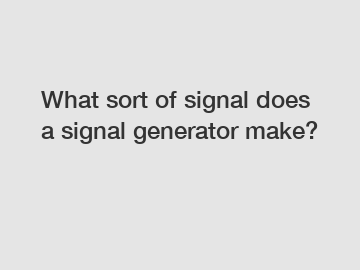What sort of signal does a signal generator make?
What Sort of Signal Does a Signal Generator Make?
A signal generator plays a crucial role in the field of electronics, as it produces electronic signals of various types and frequencies. These signals are used for a wide range of purposes, including testing electronic devices, calibrating equipment, and troubleshooting electrical systems. In this article, we will explore the different types of signals that a signal generator can produce and their applications.
Types of Signals Produced by a Signal Generator.

1. Continuous Wave (CW) Signal.
A continuous wave signal is a sine wave that is produced without any modulation. It has a constant frequency, amplitude, and phase. This type of signal is commonly used for testing and aligning radio frequency (RF) circuits and equipment. It allows engineers to check the response of a device or measure its gain and bandwidth accurately.
2. Modulated Signal.
Modulated signals are created by combining a high-frequency carrier wave with a lower frequency wave known as the modulating signal. This process adds information to the carrier wave, allowing it to carry data or transmit audio signals. Some common types of modulation include amplitude modulation (AM), frequency modulation (FM), and phase modulation (PM). Modulated signals are widely used in telecommunications, broadcasting, and audio systems.
3. Arbitrary Waveform.
Unlike continuous wave and modulated signals, an arbitrary waveform generator (AWG) can produce signals with complex shapes. AWGs have the capability to generate custom waveforms based on user-defined mathematical equations or pre-programmed patterns. This allows engineers to simulate real-world signals accurately and test electronic devices under various conditions.
Applications of Signal Generators.
1. Research and Development.
Signal generators are extensively used in research and development laboratories to test and evaluate electronic components and systems. They help engineers analyze the behavior and performance of devices, verify design specifications, and identify potential issues. The flexibility of signal generators allows researchers to simulate a wide range of real-world scenarios and advance the development of new technologies.
2. Troubleshooting and Maintenance.
Signal generators are invaluable tools for diagnosing and troubleshooting electrical systems and equipment. By injecting specific signals into circuits, engineers can pinpoint faults, identify weak components, and conduct detailed analysis. Signal generators with frequency sweep capabilities are particularly effective in detecting resonant frequencies and circuit irregularities.
3. Calibration.
Many electronic instruments and devices require regular calibration to ensure accurate measurements and proper operation. Signal generators are used during the calibration process to provide a known reference signal for comparison. By comparing the output of the instrument under test to the known signal generated by the generator, technicians can accurately calibrate devices such as oscilloscopes, spectrum analyzers, and filters.
In conclusion, a signal generator can produce a wide variety of signals, ranging from simple continuous waves to complex modulated and arbitrary waveforms. These signals play a crucial role in testing, calibrating, and troubleshooting electronic devices and systems. The versatility and precision of signal generators make them indispensable tools in the field of electronics.
If you are interested in learning more about signal generators or need assistance with any electronics-related inquiries, please do not hesitate to contact us.
If you want to learn more, please visit our website Power Quality Analyzer, Spectrum Analyzer Low Cost, Power Analyzer.

Comments
0